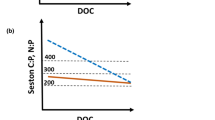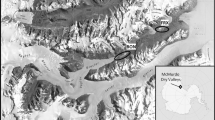Abstract
Bacteria and other microorganisms in the pelagic zone participate in the recycling of organic matter and nutrients within the water column. The microbial loop is thought to enhance ecosystem efficiency through rapid recycling and reduced sinking rates, thus reducing the loss of nutrients contained in organisms remaining within the photic zone. We conducted experiments with lake communities in 5400-liter mesocosms, and measured the flux of materials and nutrients out of the water column. A factorial design manipulated 8 nutrient treatments: 4 phosphorus levels × 2 nitrogen levels. Total sedimentation rates were greatest in high-N mesocosms; within N-surplus communities, ⩾1 µM P resulted in 50% increase in total particulate losses. P additions without added N had small effects on nutrient losses from the photic zone; +2 µM P tanks received 334 mg P per tank, yet after 14 days lost only 69 mg more particulate-P than did control communities. Nutrient treatments resulted in marked differences in phytoplankton biomass (twofold N effect, fivefold P effect in +N mesocosms only), bacterioplankton densities (twofold N-effect, twofold P effects in -N and +N mesocosms), and the relative importance of autotrophic picoplankton (maximum in high NY mesocosms). Multiple regression analysis found that of 8 plankton and water chemistry variables, the ratio of autotrophic picoplankton to total phytoplankton (measured as chlorophyll α) explained the largest portion of the total variation in sedimentation loss rates (65% of P-flux, 57% of N-flux, 26% of total flux). In each case, systems with greater relative importance of autotrophic picoplankton had significantly reduced loss rates. In contrast, greater numbers of planktonic bacteria were associated with increased sedimentation rates and lower system efficiency. We suggest that different microbial components may have contrasting effects on the presumed enhanced efficiency provided by the microbial loop.
Similar content being viewed by others
References
American Public Health Association (1985) Standard methods for the analysis of water and wastewater, 16th ed. APHA, Washington DC
Andersen OK, Goldman JC, Caron DA, Dennett MR (1986) Nutrient cycling in a microflagellate food chain. III. Phosphorus dynamics. Mar Ecol Progr Ser 31:47–55
Azam F, Fenchel T, Field JG, Meyer-Reil LA, Thingstad F (1983) The ecological role of water-column microbes in the sea. Mar Ecol Progr Ser 10:257–263
Berman T (1985) Uptake of [32p]orthophosphate by algae and bacteria in Lake Kinneret. J Plankton Res 7:71–84
Berman T, Nawrocki M, Taylor GT, Karl DM (1987) Nutrient flux between bacteria, bacterivorous nanoplanktonic protists, and algae. Mar Microb Food Webs 2:69–82
Bloem J, Albert C, Bar-Gillisen M-JB, Berman T, Cappenberg TE (1989) Nutrient cycling through phytoplankton, bacteria, and protozoa in selectively filtered Lake Vechten water. J Plankton Res 11:119–131
Bloesch J, Uehlinger U (1986) Horizontal sedimentation differences in a eutrophic Swiss lake. Limnol Oceanogr 31:1094–1109
Bloesch J, Bums NM (1980) A critical review of sediment trap technique. Schweiz Z Hydrol 42:15–55
Bran+Luebbe Analyzing Technologies (1986) Orthophosphate in water and seawater. Industrial Method No. 812-86T
Bran+Luebbe Analyzing Technologies (1986) Ammonia in water and seawater. Industrial Method No. 804-86T
Bran+Luebbe Analyzing Technologies (1987) Nitrate/nitrite in water and seawater. Industrial Method No. 818-87T
Bran+Luebbe Analyzing Technologies (1987) Silicates in water and wastewater. Industrial Method No. 785-86T
Burns CW, Stockner JG (1991) Picoplankton in six New Zealand lakes: abundance in relation to season and trophic state. Int Rev Ges Hydrobiol 76:523–536
Caron D (1991) Evolving role of protozoa in aquatic nutrient cycles. In: Reid PC et al (eds) Protozoa and their role in marine processes. (NATO-ASI Series, vol G25) Springer-Verlag, Heidelberg
Coveney MF, Wetzel RG (1992) Effects of nutrients on specific growth rate of bacterioplankton in oligotrophic lake water cultures. Appl Environ Microbiol 58:150–156
Currie DJ, Bentzen E, Kalff J (1986) Does algal-bacterial phosphorus partitioning vary among lakes? A comparative study of orthophosphate uptake and alkaline phosphatase activity in freshwater. Can J Fish Aquat Sci 43:311–318
Dodds WK, Priscu JC, Ellis BK (1991) Seasonal uptake and regeneration of inorganic nitrogen and phosphorus in a large oligotrophic lake: size-fractionation and antibiotic treatment. J Plankton Res 13:1339–1358
Goldman JC (1984) Conceptual roles for microaggregates in pelagic waters. Bull Mar Sci 35:462–476
Glover HE (1985) The physiology and ecology of the marine cyanobacterial genus Synechococcus. Adv Aquat Microbiol 3:49–107
Hargrave BT, Burns NM (1979) Assessment of sediment trap collection efficiency. Limnol Oceanogr 24:1124–1136
Hessen DO, Andersen T (1992) The grazer-algae interface: feedback mechanisms linked to elemental ratios and nutrient cycling. Arch Hydrobiol Beih Ergebn Limnol 35:111–120
Hobbie JE, Daley J, Jasper S (1977) Use of nuclepore filters for counting bacteria by fluorescence microscopy. Appl Environ Microbiol 33:1225–1228
Hopcraft RR, Roff JC, Berges JA (1990) Size-fractionated sedimentation in a tropical neritic ecosystem near Kingston, Jamaica. Cont Shelf Res 10:795–806
Kirchner WB (1975) An evaluation of sediment trap methodology. Limnol Oceanogr 20:657–660
Le J, Wehr JD, Campbell L (1993) Uncoupling of inorganic nutrient-limited bacterioplankton growth from phytoplankton. Submitted to Appl Environ Microbiol
Lewis MR, Warnock RE, Platt T (1986) Photosynthetic response of marine picoplankton at low photon flux. In: Platt T, Li WKW (eds) Photosynthetic picoplankton. Can Bull Fish Aquat Sci 214:235–250
Lorenzen CJ (1967) Determination of chlorophyll and pheo-pigments: spectrophotometric equations. Limnol Oceanogr 12:343–346
Mazumder A, Taylor WD, McQueen DJ, Lean DRS (1989) Effects of fertilization and planktivorous fish on epilimnetic phosphorus and phosphorus sedimentation in large enclosures. Can J Fish Aquat Sci 46:1735–1742
Menzel DW, Corwin N (1965) The measurement of total phosphorus in seawater based upon the liberation of organically bound fractions of persulfate oxidation. Limnol Oceanogr 10:280–282
Olsen Y, Jensen A, Reinertsen H, Bøtrsheim KY, Heldal M, Langeland A (1986) Dependence of the rate of release of phosphorus by zooplankton on the P:C ratio in the food supply, as calculated by a recycling model. Limnol Oceanogr 31:34–44
Porter KG, Feig YS (1980) The use of DAPI for identifying and counting aquatic microflora. Limnol Oceanogr 25:943–948
Schindler DW (1977) Evolution of phosphorus limitation in lakes. Science 195:260–262
Sherr EB, Sherr BF (1991) Planktonic microbes: tiny cells at the base of the ocean's food webs. Trends Ecol Evol 6:50–54
Sieburth JMcN, Smetacek V, Lenz J (1978) Pelagic ecosystem structure: heterotrophic compartments of the plankton and their relationship to plankton size fractions. Limnol Oceanogr 23:1256–1263
Stockner JG, Antia NJ (1986) Algal picoplankton from marine and freshwater ecosystems: a multidisciplinary perspective. Can J Fish Aquat Sci 43:2472–2503
Stockner JG, Shortreed KS (1988) Response of Anabaena and Synechococcus to manipulation of nitrogen:phosphorus ratios in a lake fertilization experiment. Limnol Oceanogr 33:1348–1361
Stone L, Weisburd SJ (1992) Positive feedback in aquatic ecosytems. Trends Ecol Evol 7:263–267
Suttle CA, Harrison PJ (1988) Ammonium and phosphate uptake rates, N:P supply ratios, and evidence for N and P limitation in some oligotrophic lakes. Limnol Oceanogr 33:186–202
Thingstad TF (1987) Utilization of N, P, and organic C by heterotrophic bacteria. 1. Outline of a chemostat theory with a consistent concept of “maintenance” metabolism. Mar Ecol Progr Ser 35:99–109
Toolan T, Wehr JD, Findlay S (1991) Inorganic phosphorus stimulation of bacterioplankton production in a meso-eutrophic lake. Appl Environ Microbiol 57:2074–2078
Wehr JD (1989) Experimental tests of nutrient limitation in freshwater picoplankton. Appl Environ Microbiol 55:1605–1611
Wehr JD (1990) Predominance of picoplankton and nanoplankton in eutrophic Calder Lake. Hydrobiologia 203:35–44
Wehr JD (1991) Nutrient and grazer-mediated effects on picoplankton and size structure in phytoplankton communities. Int Rev Ges Hydrobiol 76:643–656
Wehr JD (1993) Effects of experimental manipulations of light and phosphorus supply on competition among picoplankton and nanoplankton in an oligotrophic lake. Can J Fish Aquat Sci 50:936–945
Wetzel RG (1983) Limnology. Saunders College Publishing, Philadelphia, Pennsylvania
Wilkinson L (1988) SYSTAT: The system for statistics. Systat, Inc., Evanston, Illinois
Author information
Authors and Affiliations
Additional information
Correspondence to: J. D. Wehr.
Rights and permissions
About this article
Cite this article
Wehr, J., Le, J. & Campbell, L. Does microbial biomass affect pelagic ecosystem efficiency? An experimental study. Microb Ecol 27, 1–17 (1994). https://doi.org/10.1007/BF00170110
Received:
Revised:
Issue Date:
DOI: https://doi.org/10.1007/BF00170110




